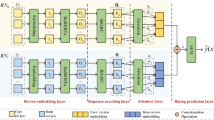Abstract
As a valuable source of user preferences and item properties, reviews have been widely leveraged in many approaches to enhance the performance of recommender systems. Although encouraging success has been obtained, there are two more weaknesses need to be addressed. (1) Most approaches represent users or items merely based on the modeling of review texts, but ignore the potential and latent preferences beyond textual information. (2) Existing methods tend to blindly merge all the previous reviews for user profiling. However, it may be less effective because different interacted items may play distinct roles. Hence, indiscriminately aligning interacted items may limit the model flexibility and performance. In this paper, with the desire to fill these gaps, we design a novel attentive deep review-based recommendation method. In specific, we complement the item representation by an auxiliary vector, based on which a user is then attentively profiled by her posted items to predict the likeness for the target item. Extensive experiments on five real-world datasets demonstrate that our model can not only significantly outperform the state-of-the-art methods, but also provide intuitive explanations to the recommendations.







Similar content being viewed by others
References
Almahairi A, Kastner K, Cho K, Courville A (2015) Learning distributed representations from reviews for collaborative filtering. In: Proceedings of the 9th ACM conference on recommender systems (RecSys), pp 147–154
Anderson P, He X, Buehler C, Teney D, Johnson M, Gould S, Zhang L (2018) Bottom-up and top-down attention for image captioning and visual question answering. In: Proceedings of the IEEE conference on computer vision and pattern recognition (CVPR), vol 3, p 6
Bahdanau D, Cho K, Bengio Y (2014) Neural machine translation by jointly learning to align and translate. In: International conference on learning representations (ICLR)
Bao Y, Fang H, Zhang J (2014) Topicmf: simultaneously exploiting ratings and reviews for recommendation. In: Proceedings of the 28th AAAI conference on artificial intelligence (AAAI), vol 14, pp 2–8
Blei DM, Ng AY, Jordan MI (2003) Latent dirichlet allocation. J Mach Learn Res 3(Jan):993–1022
Catherine R, Cohen W (2017) Transnets: Learning to transform for recommendation. In: Proceedings of the eleventh ACM conference on recommender systems (RecSys), pp 288–296
Chen J, Zhang H, He X, Nie L, Liu W, Chua TS (2017) Attentive collaborative filtering: multimedia recommendation with item-and component-level attention. In: Proceedings of the 40th international ACM SIGIR conference on research and development in information retrieval (SIGIR), pp 335–344
Chen X, Zhang Y, Ai Q, Xu H, Yan J, Qin Z (2017) Personalized key frame recommendation. In: Proceedings of the 40th international ACM SIGIR conference on research and development in information retrieval (SIGIR). ACM, pp 315–324
Cho K, Van Merriënboer B, Gulcehre C, Bahdanau D, Bougares F, Schwenk H, Bengio Y (2014) Learning phrase representations using rnn encoder–decoder for statistical machine translation. In: Proceedings of the 2014 conference on empirical methods in natural language processing (EMNLP)
Cui L, Huang W, Yan Q, Yu FR, Wen Z, Lu N (2018) A novel context-aware recommendation algorithm with two-level svd in social networks. Future Gener Comput Syst 86:1459–1470
Cui L, Ou P, Fu X, Wen Z, Lu N (2017) A novel multi-objective evolutionary algorithm for recommendation systems. J Parallel Distrib Comput 103:53–63
Glorot X, Bengio Y (2010) Understanding the difficulty of training deep feedforward neural networks. In: Proceedings of the thirteenth international conference on artificial intelligence and statistics, pp 249–256
Guo G, Zhang J, Thalmann D (2012) A simple but effective method to incorporate trusted neighbors in recommender systems. In: International conference on user modeling, adaptation, and personalization (UMAP). Springer, pp 114–125
Guo G, Zhang J, Yorke-Smith N (2015) Trustsvd: collaborative filtering with both the explicit and implicit influence of user trust and of item ratings. In: Twenty-ninth AAAI conference on artificial intelligence (AAAI)
He X, Liao L, Zhang H, Nie L, Hu X, Chua T-S (2017) Neural collaborative filtering. In: Proceedings of the 26th international conference on world wide web (WWW), pp 173–182
Hochreiter S, Schmidhuber J (1997) Long short-term memory. Neural Comput 9(8):1735–1780
Jin M, Luo X, Zhu H, Zhuo HH (2018) Combining deep learning and topic modeling for review understanding in context-aware recommendation. In: Proceedings of the 2018 conference of the north american chapter of the association for computational linguistics: human language technologies, pp 1605–1614
Kabbur S, Ning X, Karypis G (2013) Fism: factored item similarity models for top-n recommender systems. In: Proceedings of the 19th ACM SIGKDD international conference on knowledge discovery and data mining (KDD), pp 659–667
Kalchbrenner N, Grefenstette E, Blunsom P (2014) A convolutional neural network for modelling sentences. In: Proceedings of the 52nd annual meeting of the association for computational linguistics (ACL), pp 655–665
Kazemi V, Elqursh A (2017) Show, ask, attend, and answer: a strong baseline for visual question answering. arXiv:1704.03162
Kim D, Park C, Oh J, Lee S, Yu, H (2016) Convolutional matrix factorization for document context-aware recommendation. In: Proceedings of the 10th ACM conference on recommender systems (RecSys), pp 233–240
Kim Y (2014) Convolutional neural networks for sentence classification. arXiv:1408.5882
Kingma D, Ba J (2015) Adam: a method for stochastic optimization. In: Proceedings of the 3rd international conference on learning representations (ICLR), pp 1–15
Koren Y (2008) Factorization meets the neighborhood: a multifaceted collaborative filtering model. In: Proceedings of the 14th ACM SIGKDD international conference on knowledge discovery and data mining (KDD), pp 426–434
Ling G, Lyu MR, King I (2014) Ratings meet reviews, a combined approach to recommend. In: Proceedings of the 8th ACM conference on recommender systems (RecSys), pp 105–112
Lu J, Yang J, Batra D, Parikh D (2016) Hierarchical question-image co-attention for visual question answering. In: Advances in neural information processing systems (NIPS), pp 289–297
McAuley J, Leskovec J (2013) Hidden factors and hidden topics: understanding rating dimensions with review text. In: Proceedings of the 7th ACM conference on recommender systems (RecSys), pp 165–172
Nair V, Hinton GE (2010) Rectified linear units improve restricted Boltzmann machines. In: Proceedings of the 27th international conference on machine learning (ICML), pp 807–814
Pennington J, Socher R, Manning C (2014) Glove: global vectors for word representation. In: Proceedings of the 2014 conference on empirical methods in natural language processing (EMNLP), pp 1532–1543
Rendle S (2010) Factorization machines. In: Proceedings of the 10th IEEE international conference on data mining (ICDM), pp 995–1000
Rendle S, Freudenthaler C, Gantner Z, Schmidt-Thieme L (2009) Bpr: Bayesian personalized ranking from implicit feedback. In: Proceedings of the twenty-fifth conference on uncertainty in artificial intelligence (UAI), pp 452–461
Seo S, Huang J, Yang H, Liu Y (2017) Interpretable convolutional neural networks with dual local and global attention for review rating prediction. In: Proceedings of the eleventh ACM conference on recommender systems (RecSys), pp 297–305
Tang J, Wang K (2018) Personalized top-n sequential recommendation via convolutional sequence embedding. In: Proceedings of the eleventh ACM international conference on web search and data mining (WSDM), pp 565–573
Vinyals O, Toshev A, Bengio S, Erhan D (2015) Show and tell: a neural image caption generator. In: Proceedings of the IEEE conference on computer vision and pattern recognition (CVPR), pp 3156–3164
Wang C, Blei DM (2011) Collaborative topic modeling for recommending scientific articles. In: Proceedings of the 17th ACM SIGKDD international conference on knowledge discovery and data mining (KDD), pp 448–456
Wang H, Wang N, Yeung DY (2015) Collaborative deep learning for recommender systems. In: Proceedings of the 21th ACM SIGKDD international conference on knowledge discovery and data mining (KDD), pp 1235–1244
Yang B, Lei Y, Liu D, Liu J (2013) Social collaborative filtering by trust. In: Twenty-third international joint conference on artificial intelligence (IJCAI)
Yang Z, He X, Gao J, Deng L, Smola A (2016) Stacked attention networks for image question answering. In: Proceedings of the IEEE conference on computer vision and pattern recognition (CVPR), pp 21–29
Zheng L, Noroozi V, Yu PS (2017) Joint deep modeling of users and items using reviews for recommendation. In: Proceedings of the tenth ACM international conference on web search and data mining (WSDM), pp 425–434
Acknowledgements
This work is supported by the Fundamental Research Funds for the Central Universities under Grant No. N181705007, and by the National Natural Science Foundation of China under Grant Nos. 61972078, 61702084 and 61702090.
Author information
Authors and Affiliations
Corresponding author
Additional information
Publisher's Note
Springer Nature remains neutral with regard to jurisdictional claims in published maps and institutional affiliations.
Rights and permissions
About this article
Cite this article
Sun, Y., Guo, G., Chen, X. et al. Exploiting review embedding and user attention for item recommendation. Knowl Inf Syst 62, 3015–3038 (2020). https://doi.org/10.1007/s10115-020-01447-2
Received:
Revised:
Accepted:
Published:
Issue Date:
DOI: https://doi.org/10.1007/s10115-020-01447-2




